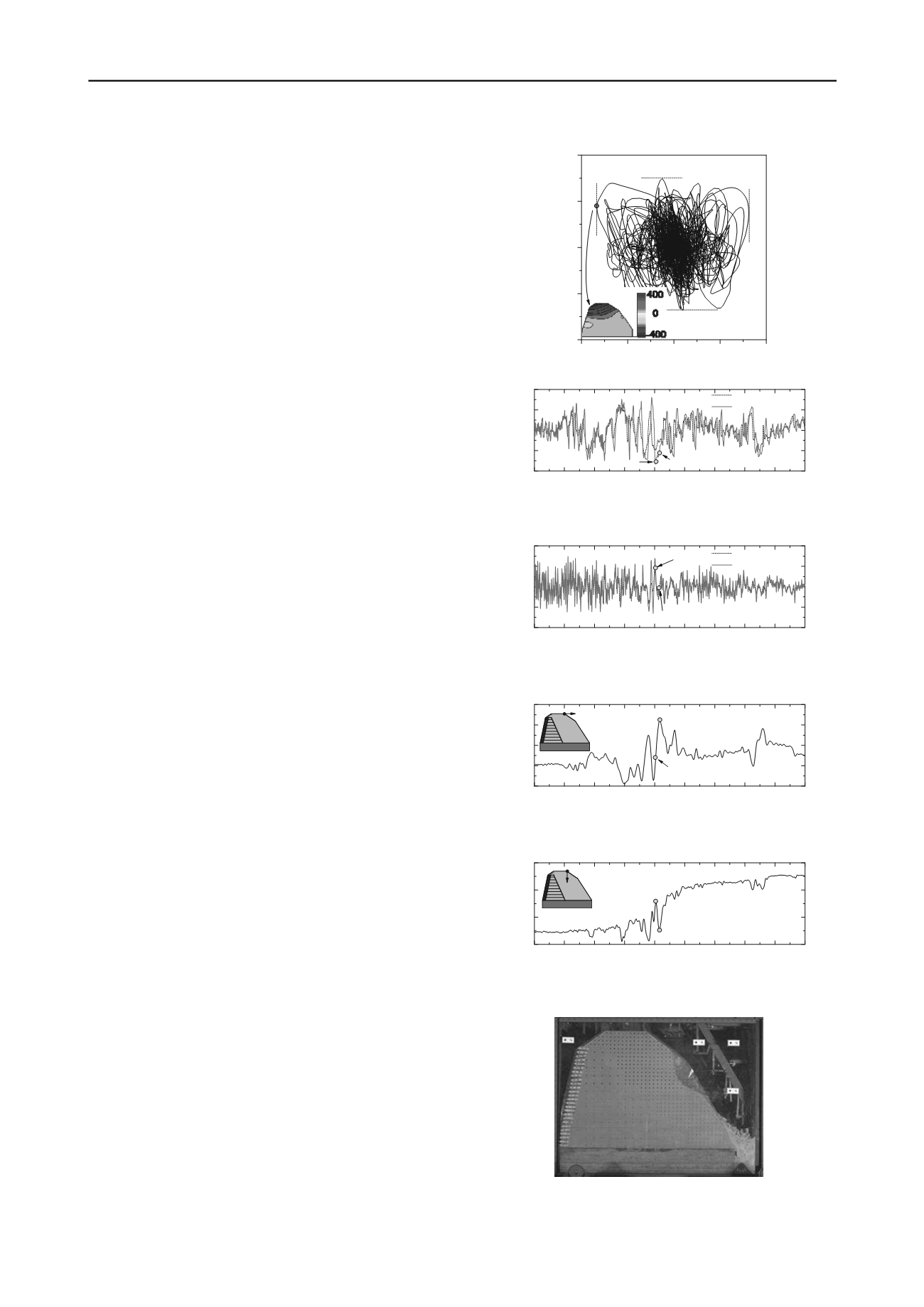
1606
Proceedings of the 18
th
International Conference on Soil Mechanics and Geotechnical Engineering, Paris 2013
on the shaking table. Contrary, the vertical acceleration
exhibited a positive value at the similar time due to the phase
difference. This indicates that the inertia force apply to the slope
in the parallel and downward direction of the slope inclination.
Figures 7 and 8 show the time histories of horizontal and
vertical accelerations measured at the shaking table and the top
of the slope. The horizontal and vertical accelerations measured
at the top of the slope increased and exhibited remarkable phase
difference as compared to those of the shaking table. Figures 9
and 10 show time histories of horizontal and vertical
displacements measured at the shaking table and the top of the
slope. The horizontal and vertical displacements measured at
the top of the slope increased in the forward and downward
directions, respectively. Here, the horizontal and vertical
accelerations exhibited -834 gal and 437 gal respectively at
19.03 s from the start of the shaking. From the test results under
the sinusoidal excitation, the horizontal acceleration increased
due the effect of the vertical acceleration when the direction of
the inertia force was the same of the slope inclination. Therefore,
due to the above trend, it is considered that the horizontal
displacement increased at 19.16 s from the start of shaking. At
19.03 s from the start of shaking, the vertical displacement
exhibited a large value due to the effect of the vertical
acceleration.
Figure 6. Record seismic wave with amplitude adjustment.
-1000 -500 0 500 1000
-1000
-500
0
500
1000
Vertical acceleration (gal)
Horizontal acceleration (gal)
-834 gal
810 gal
-679 gal
744 gal
19.03s
15 16 17 18 19 20 21 22 23 24
-1000
-500
0
500
1000
Shaking table
Top of the slope
19.16 s
19.03 s
Acceleration (gal)
Time (s)
This slope model collapsed at the surface layer as shown in
Figure 11. This is probably due to the phase difference between
the shaking table and the slope caused by the large amplification
of the acceleration.
Figure 7. Time histories of horizontal acceleration measured at the
shaking table and top of the slope.
CONCLUSION
This paper describes an effect of vertical acceleration against
dynamic response and deformation characteristics of the slope
model subjected to horizontal and vertical sinusoidal and
irregular excitation using a large-scaled shaking table. From the
test results, it is revealed that there is a instability situation that
a direction of inertia force applyed to the slope model in the
parallel direction of the slope inclination.
15 16 17 18 19 20 21 22 23 24
-1000
-500
0
500
1000
Acceleration (gal)
Time (s)
Shaking table
Top of the slope
19.16 s
19.03 s
Figure 8. Time histories of vertical acceleration measured at the shaking
table and top of the slope.
For more precise evaluation of the slope exhibiting large
response and phase difference, an appropriate method to
evaluate the effect of horizontal and vertical accelerations such
as dynamic finite element method should be used. Subsequently,
the slope stability can be evaluated to calculate the safety factor
at each time step using the analytical response and phase
difference calculated by the above dynamic finite element
analysis. This method will be reported in the near future.
15 16 17 18 19 20 21 22 23 24
-20
0
20
40
60
Horizontal displacement
at the top of the slope (mm)
Time (s)
19.03 s
19.16 s
+
Figure 9. Time histories of horizontal displacement at the top of the
slope.
REFERENCES
JEAG4601-1987,
Technical Guidelines for Aseismic Design of Nuclear
Power Plants
, 1987.
Ishimaru, M. and Kawai, T.: “Basic study of the evaluation of seismic
stability of rock slope using centrifuge model test”,
Journal of
Japan Society of Civil Engineers
, Ser. C, Vol. 67, No. 1, pp.36–49,
2011 (in Japanese).
Figure 10. Time histories of vertical displacement at the top of the slope.
15 16 17 18 19 20 21 22 23 24
5
10
15
20
Time (s)
19.16 s
Vertical displacement
at the top of the slope (mm)
19.03 s
+
Ling, H. I., Leshchinsky, D. and Mohri, Y.: Soil Slopes under
Combined Horizontal and Vertical Seismic Accelerations,
Earthquake Engineering and Structural Dynamics
, Vol. 26,
pp.1231-1241, 1997.
Figure 11. Slope failure under recorded seismic excitation
.


